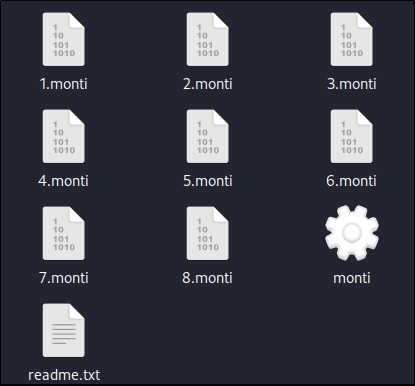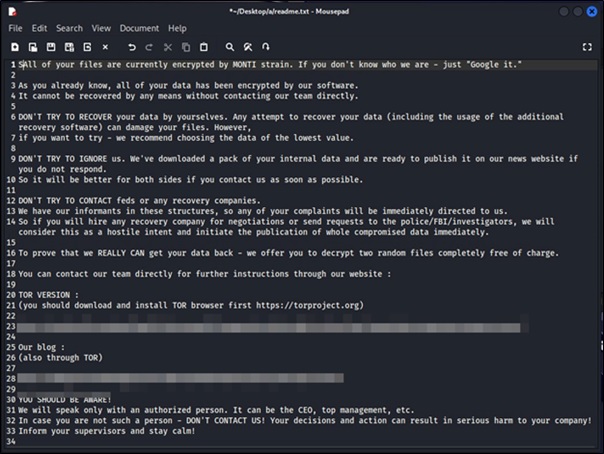Monti Ransomware
Original Issue Date:-
August 22, 2023
Virus Type:- Ransomware
Severity:-
Medium
It has been reported that a new variant of Monti ransomware is targeting organizations for malicious activities. In the new variant, linux locker is employed which infect VMware ESXi servers, various organizations.
Infection Mechanism
As observed, this variant of Monti ransomware shows somewhat similarity with source code of Conti ransomware. The variant adds some new parameters for stealthy operation and evading detection. Additionally, they employ the AES-256-CTR encryption, which depends on the file size for its encryption procedure.
The encryption strategy depends on the file size i.e. if a file's size falls between 1.048 MB and 4.19 MB, only the initial 100,000 bytes will be subjected to encryption. In contrast, if file size is more than 4.19 MB then the extent of content encryption for a specific portion is determined. Files less than 1.048 MB would be encrypted completely. While encrypting the content, it appends bytes “MONTI” along with 256 bytes that are related to attacker’s encryption key.
After encrypting the file, the new variant of Monti ransomware appends the “ .MONTI” extension to the encrypted files and creates a ransom note ('readme.txt') in every directory it operates on.

The ransom note includes details regarding instructions for exchanging the decryption key, along with information about the pilfered data and links for communication and negotiation.

Furthermore, it is worth noting that altering source code of the Conti ransomware makes it tough to identify and mitigate this malware.
Indicator of Compromise:
SHA 1:
- f1c0054bc76e8753d4331a881cdf9156dd8b812a
- a0c9dd3f3e3d0e2cd5d1da06b3aac019cdbc74ef
URLs:
- hxxp://monti5o7lvyrpyk26lqofnfvajtyqruwatlfaazgm3zskt3xiktudwid[dot]onion
- hxxp://mblogci3rudehaagbryjznltdp33ojwzkq6hn2pckvjq33rycmzczpid[dot]onion
Best Practices and Recommendations:
- Maintain offline backups of data, and regularly maintain backup and restoration. This practice will ensure the organization will not be severely interrupted, have irretrievable data.
- Ensure all backup data is encrypted, immutable (i.e., cannot be altered or deleted) and covers the entire organization’s data infrastructure.
- Implement all accounts with strong & unique passwords (e.g., service account, admin accounts, and domain admin accounts).
- Implement multi-factor authentication for all services to the extent possible, particularly for webmail, virtual private networks, and accounts that access critical systems.
- Remove unnecessary access to administrative shares.
- Use a host-based firewall to only allow connections to administrative shares via server message block (SMB) from a limited set of administrator machines.
- Enable protected files in the Windows Operating System to prevent unauthorized changes to critical files.
- Disable remote Desktop Connections, employ least-privileged accounts. Limit users who can log in using Remote Desktop, set an account lockout policy. Ensure proper RDP logging and configuration.
- Check regularly for the integrity of the information stored in the databases.
- Ensure integrity of the codes /scripts being used in database, authentication and sensitive system.
- Establish Domain-based Message Authentication, Reporting, and Conformance (DMARC), Domain Keys Identified Mail (DKIM) and Sender Policy Framework (SPF) for your domain, which is an email validation system designed to prevent spam by detecting email spoofing by which most of the ransomware samples successfully reaches the corporate email boxes.
- Keep the operating system, third party applications (MS office, browsers, browser Plugins) up-to-date with the latest patches.
- Application white listing/Strict implementation of Software Restriction Policies (SRP) to block binaries running from %APPDATA% and %TEMP% paths. Ransomware sample drops and executes generally from these locations.
- Maintain updated Antivirus software on all systems.
- Don't open attachments in unsolicited e-mails, even if they come from people in your contact list, and never click on a URL contained in an unsolicited e-mail, even if the link seems benign. In cases of genuine URLs close out the e-mail and go to the organization's website directly through browser.
- Follow safe practices when browsing the web. Ensure the web browsers are secured enough with appropriate content controls.
- Network segmentation and segregation into security zones - help protect sensitive information and critical services. Separate administrative network from business processes with physical controls and Virtual Local Area Networks.
- Restrict access using firewalls and allow only to selected remote endpoints, VPN may also be used with dedicated pool for RDP access.
- Use strong authentication protocol, such as Network Level Authentication (NLA) in Windows.
- Disable ActiveX content in Microsoft Office applications such as Word, Excel, etc.
- Additional Security measures that may be considered are:
- Use RDP Gateways for better management.
- Change the listening port for Remote Desktop.
- Tunnel Remote Desktop connections through IPSec or SSH.
- Two-factor authentication may also be considered for highly critical systems.
- If not required consider disabling PowerShell / windows script hosting.
- Restrict users' abilities (permissions) to install and run unwanted software applications.
- Enable personal firewalls on workstations.
- Implement strict External Device (USB drive) usage policy.
- Employ data-at-rest and data-in-transit encryption.
- Consider installing Enhanced Mitigation Experience Toolkit, or similar host-level anti-exploitation tools.
- Block the attachments of file types, exe|pif|tmp|url|vb|vbe|scr|reg|cer|pst|cmd|com|bat|dll|dat|hlp|hta|js|wsf
- Carry out vulnerability Assessment and Penetration Testing (VAPT) and information security audit of critical networks/systems, especially database servers from CERT-IN empanelled auditors. Repeat audits at regular intervals.
- Individuals or organizations are not encouraged to pay the ransom, as this does not guarantee files will be released. Report such instances of fraud to CERT-In and Law Enforcement agencies.
References:
- https://www.trendmicro.com/en_us/research/23/h/monti-ransomware-unleashes-a-new-encryptor-for-linux.html
- https://thehackernews.com/2023/08/monti-ransomware-returns-with-new-linux.html
- https://www.bleepingcomputer.com/news/security/monti-ransomware-targets-vmware-esxi-servers-with-new-linux-locker
- https://therecord.media/monti-ransomware-targets-govt-entities
- https://www.csk.gov.in/alerts/ransomware.html


